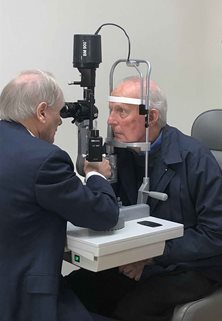August 17, 2021 Print
This Survey called the ‘Australian Eye and Ear Health Survey’ will examine close to 5,000 Aboriginal and Torres Strait Islander peoples and non-Aboriginal Australians over a period of two years.
The 2016 National Eye Health Survey was the first nationwide survey to determine the prevalence and major causes of vision impairment and blindness in Aboriginal and Torres Strait Islander peoples and non-Indigenous Australians in city, regional and remote areas. In view of increased prevalence of diabetes since the 2016 Survey and the critical eye complications that may follow, the Australian Government Department of Health has sponsored the call to conduct a Second National Eye Health Survey.
The Centre for Vision Research at The Westmead Institute for Medical Research (WIMR) and partners including the University of New South Wales, The George Institute for Global Health, the Brien Holden Foundation and Macquarie University are proud to announce the award of the tender to conduct this Survey with an added Ear Health component as part of this nationwide survey.
This Survey called the ‘Australian Eye and Ear Health Survey’ will examine close to 5,000 Aboriginal and Torres Strait Islander peoples and non-Aboriginal Australians over a period of two years.
Professor Paul Mitchell AO, Director of WIMR’s Centre for Vision Research w

ho will lead the study, says, “Having a thorough and accurate understanding of the prevalence of eye disease and hearing loss in Australia is essential. It allows us to anticipate and plan prevention and treatment approaches that address the issues of vision and hearing loss now, and well into the future.”
Macquarie University has provided support to ensure assessment of ear health occurs in parallel to the collection of data on eye and general health measures in this Survey. The ear health component of this Survey will be led by Professor Bamini Gopinath, Cochlear Chair in Hearing and Health at Macquarie University Hearing. Professor Gopinath says, “We have a unique opportunity to expand the scope of the Second National Eye Health Survey to also establish prevalence, risk factors and impacts of hearing loss in Australia. This will not only help to determine the current state of hearing health in Australia, but it will provide vital information to the Government to assist in its policy development, guiding future resource allocation and hearing health service delivery.”
According to Australian statistics, more than 453,000 people who are blind or vision impaired are currently living in Australia. Hearing loss has been reported in even more people with over 3 million Australians (14%) affected. The presence of long-term hearing loss also increases with age, affecting 49% of Australians aged 75 years and older.
Vision and hearing loss remain key health issues, particularly for Aboriginal and Torres Strait Islander peoples. In 2016, the Australian Institute of Health and Welfare (AIHW) estimated that 18,300 Aboriginal and Torres Strait Islander peoples aged 40 and over had a vision impairment or were blind, and that the three leading causes of vision loss for Aboriginal and Torres Strait Islander peoples aged 40 and over were refractive error (61%), cataract (20%) and diabetic retinopathy (5.5%). In 2018-19, data from the National Aboriginal and Torres Strait Islander Health Survey (NATSIHS) reported that among Aboriginal and Torres Strait Islander peoples, hearing loss was prevalent in 62% of those aged 45 to 54 years and 81.8% of those aged 55 years and over.
Professor Mitchell says, “Our study will use new, non-invasive imaging technologies to help improve eye disease detection rates. Importantly, it will assess a broad representation of people from across Australia. We will also look to assess potential links between eye disease/vision and hearing loss and critical health and/or social outcomes.”
“The WIMR Centre for Vision Research and partners are honoured to have been entrusted with this important study, and proud to be playing this vital role in improving the vision and hearing of all Australians,” says Professor Mitchell.
The Australian Eye and Ear Health Survey will begin in the coming months starting in NSW, and is expected to run for two years. Local doorknockers will invite residents living in the eligible communities to participate in the Survey.
Reporting from the Australian Eye and Ear Health Survey will contribute to Australia’s commitment to eradicate avoidable blindness in fulfilment of the United Nations General Assembly resolution
Vision for Everyone: accelerating action to achieve the Sustainable Development Goals; and
Integrated people-centred eye care, including preventable vision impairment and blindness, adopted by World Health Organisation Member States. The Survey will also fulfil several of the key priorities and actions outlined in Australia’s Roadmap for Hearing Health.